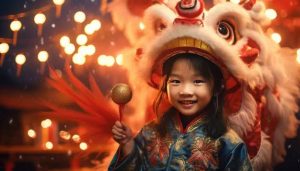Among China’s traditional holidays and celebrations, none ranks higher in importance than the Lunar New Year (農曆新年). Also known as the Spring Festival (春節), or simply Chinese New Year, it marks the beginning of the year according to the traditional lunar calendar.
The Lunar New Year usually starts sometime between late January and mid-February. In mainland China, official celebrations last for seven days as a public holiday. This Lunar New Year, which falls on Feb. 10, is the Year of the Dragon.
Food, gifts and celebrations
 At its core, the Lunar New Year is a celebration that brings the family together. Preparations start a week in advance and include cleaning and decorating the home, as well as shopping, especially for gifts and provisions, and food preparation.
At its core, the Lunar New Year is a celebration that brings the family together. Preparations start a week in advance and include cleaning and decorating the home, as well as shopping, especially for gifts and provisions, and food preparation.
A central event is the family dinner on the eve of the new year. The choice of dishes varies, reflecting family customs and local culinary traditions. Often it includes dumplings, spring rolls, cakes, fish and pork dishes. There is also a fair amount of drinking, especially traditional wines or liquor. Many of the dishes are assigned symbolic meanings. For instance, dumplingsare given the shape of gold ingots to invoke good fortune.
Other customs associated with Lunar New Year celebrations include the giving of red envelopes containing money, usually by elders to younger members of the family. The red color, which is also featured prominently in Lunar New Year decorations, symbolizes prosperity and good fortune.
Year of the Dragon
Traditionally, the dragon is an auspicious symbol of strength and power. It is also associated with good fortune, wisdom, success, protection and masculinity. In pre-modern China, it was associated with imperial rule and was prominently featured on the first Chinese flag, initially instituted by the Qing dynasty in 1862. To this day, a dragon image is often used to symbolize China itself.
Because of the dragon’s auspicious associations, dragon years tend to bring upticks in fertility rates. Considering China’s current shrinking population and deepening fertility crisis, some are expressing hope for a baby boom during the coming year, as certain parents may be motivated to bring dragon children into the world.
According to the Chinese zodiac signs, each year in the lunar cycle is associated with a particular animal. This is a 12-year cycle that repeats itself. Thus, there are 12 animals, each associated with a year in the cycle: rat, ox, tiger, rabbit, dragon, snake, horse, goat, monkey, rooster, dog and pig.
Among the popular myths about the origins of the Chinese zodiac is one about a great race initiated by the Jade Emperor, the ruler of heaven, in order to measure time. As the rat won the race, it came to be listed first among the 12 animals of the zodiac. The order of the other 11 animals reflected their final position in the race. Each of the 12 zodiac animals came to represent certain characteristics believed to shape the personalities of individuals born in those years, with the dragon often considered to be the most auspicious of all.
Origins of the lunar calendar
Traditionally, the Chinese have followed their native lunar calendar, which is based on observations and measurements of astronomical phenomena. While modern China adopted the Gregorian calendar in 1912, traditional festivals such as the Lunar New Year still follow the old lunar calendar.
The origins of the lunar calendar may go back to the dawn of Chinese civilization, traditionally associated with the legendary Xia dynasty, said to have ruled from 2070 to 1600 B.C. The origins of the Lunar New Year celebrations are also not entirely clear; some scholars believe they likely go back to the rule of the Shang dynasty, which lasted from 1600 to 1050 B.C.
Over the centuries, the coming together for the Lunar New Year celebration has remained an important part of the cultural heritage for Chinese families, connecting the past to the present, wherever they happen to be. (The Conversation)



